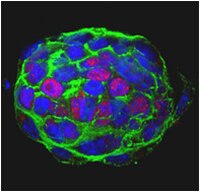MABE1132 Sigma-AldrichAnti-TET2 Antibody, clone 9F7
Anti-TET2 Antibody, clone 9F7 is an antibody against TET2 for use in Immunocytochemistry, Western Blotting, Immunoprecipitation, ELISA.
More>> Anti-TET2 Antibody, clone 9F7 is an antibody against TET2 for use in Immunocytochemistry, Western Blotting, Immunoprecipitation, ELISA. Less<<Productos recomendados
Descripción
| Replacement Information |
|---|
Tabla espec. clave
| Species Reactivity | Key Applications | Host | Format | Antibody Type |
|---|---|---|---|---|
| M | ICC, WB, IP, ELISA | R | Purified | Monoclonal Antibody |
| References |
|---|
| Product Information | |
|---|---|
| Format | Purified |
| Presentation | Purified rat monoclonal IgG2aκ antibody in buffer containing 0.1 M Tris-Glycine (pH 7.4), 150 mM NaCl with 0.05% sodium azide. |
| Quality Level | MQ100 |
| Physicochemical Information |
|---|
| Dimensions |
|---|
| Materials Information |
|---|
| Toxicological Information |
|---|
| Safety Information according to GHS |
|---|
| Safety Information |
|---|
| Storage and Shipping Information | |
|---|---|
| Storage Conditions | Stable for 1 year at 2-8°C from date of receipt. |
| Packaging Information | |
|---|---|
| Material Size | 100 μg |
| Transport Information |
|---|
| Supplemental Information |
|---|
| Specifications |
|---|
| Global Trade Item Number | |
|---|---|
| Número de referencia | GTIN |
| MABE1132 | 04055977350920 |
Documentation
Anti-TET2 Antibody, clone 9F7 Ficha datos de seguridad (MSDS)
| Título |
|---|
Anti-TET2 Antibody, clone 9F7 Certificados de análisis
| Cargo | Número de lote |
|---|---|
| Anti-TET2, clone 9F7 - 3419592 | 3419592 |
| Anti-TET2, clone 9F7 - 3899556 | 3899556 |
| Anti-TET2, clone 9F7 - 4042589 | 4042589 |
| Anti-TET2, clone 9F7 -Q2683388 | Q2683388 |







